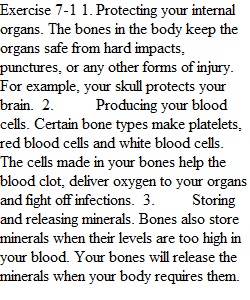


Q For this assignment, you will complete the Study Guide Exercises for Chapter 7. To access your Study Guide for Memmler's The Human Body in Health and Disease, Enhanced Edition please revisit your VitalSource Bookshelf Module. Below is a complete list of each exercise that should be completed. As with other assignments, please carefully read the instructions and each question. Some questions will include activities, while others will include questions that will require you to "fill-in-the-blank" or provide a long-form answer. Note that long-form answers should be at least 50 to 100 words in length. Additionally, please format your responses with the correct question number (1) or question letter (A) that correlates to your answer. Your responses should be submitted as a file upload. HINT: Copy and paste the study guide questions/exercises into a Word or Google document; this will allow you to type in your response to each question! If you have any questions, please reach out to your instructor! ________________________________________ Chapter 7 - Study Guide Exercises Please complete the Exercises outlined below. For any exercise that requires you to COLOR a section of a diagram, please write out the color that you would color it as your answer. o Exercises 7-1 through Exercises 7-19 • ? Exercise 7-9, ONLY complete question #3. ? Exercise 7-10, ONLY complete question #2. ? Exercise 7-11, ONLY complete question #1. ? Exercise 7-12, ONLY complete question #1. ? Exercise 7-16, ONLY complete question #1. ? Exercise 7-17, ONLY write the names of the illustrated bones, do not color. ? Exercise 7-18, ONLY write the names of the illustrated bones, do not color. ? Exercise 7-19, ONLY complete question #3. o Making the Connections o Testing Your Knowledge (Multiple Choice) o Completion Exercise o Understanding Concepts (True/False and Practical Applications) Rubric Applied Learning/Lab - Study Guide Exercises Applied Learning/Lab - Study Guide Exercises Criteria Ratings Pts This criterion is linked to a Learning OutcomeCompletion 5 pts Complete All questions are complete, and each response is adequate in format/length. 3 pts Partially Complete At least 3/4 of the questions are complete, and each response is adequate in format/length. 0 pts Incomplete Less than 3/4 of the questions answered, answers are in inadequate format/length, and/or no submission. 5 pts This criterion is linked to a Learning OutcomeUnderstanding and Comprehension 35 to >30.0 pts Excellent Upon review, the study guide answers provided are accurate; please review your submission for feedback and remediation tips! 30 to >20.0 pts Room for Improvement Upon review, some of the study guide answers are accurate; please review your submission for feedback and remediation tips! 20 to >0 pts Poor Upon review, very few of the study guide answers are accurate; please review your submission for feedback and remediation tips! 35 pts Total Points: 40 PreviousNext
View Related Questions